The culmination of three years of work, researchers from the University of New South Wales (UNSW) have discovered a low-cost sulphur-based additive that can boost the stability of perovskite solar cells without compromising efficiency.
The additive, known as 1-DDT (Dodecanethiol), has a “multifunction” – something which came as a surprise to the UNSW School of Photovoltaic and Renewable Energy Engineering team. On top of stabilising the lithium used in the hole transport layer of perovskite cells to achieve high efficiencies, the additive also induces oxidation and prevents water ingression – both features which add to stability.
“This 1-DDT locks lithium in that layer, and I think thats a major contribution and a major underlying mechanism to make this stable,” research lead Professor Xiaojing Hao tells pv magazine Australia.
Costing just $0.049 (0.033 USD) per gram, the additive doesn’t take away from perovskites promise of cheap manufacturability.
Perovskite cells fabricated using this novel additive were able to maintain more than 90% of the initial efficiency after operating at maximum power point under one sun illumination for 1,000 hours, and more than 93% of the initial efficiency after staying at open circuit condition under one sun illumination for 2,000 hours. This reported stability result is the best in Australia and among the highest in the world.
The results of the research have now been published in Nature Photonics and have been co-authored by Professor Martin Green, famously known as the ‘father’ of modern solar cells, with Xu Liu lead author.

Image: University of New South Wales
The issue
While perovskites’ high efficiencies are proven, “everyone still has concerns in terms of long term stability,” Professor Hao says.
Historically, perovskite cells have had a tradeoff between high efficiency and good stability because of something known as the hole transport layer. One of the most widely used materials used in perovskites’ hole transport layer is Spiro-OMeTAD.
Spiro, as Professor Hao calls it, is behind all record-setting perovskite cells which have achieved efficiencies beyond 25%.
While Spiro is excellent for efficiency, it typically requires chemical doping with a lithium compound – something the UNSW team found decreases cell stability. “Lithium causes the stability issue,” Professor Hao says, but it is also the “secret recipe” which gives the layer its desirable electrical properties.

After identifying that Spiro’s issues start with its lithium salt doping prerequisite, the UNSW team set about finding a way to “lock” the lithium in the layer. Inspired by research into lithium-sulfide batteries which found the combination of lithium and sulphur makes stable compounds, the team began experimenting with sulphur-based chemicals.
“But we didn’t expect it also would generate something that would make it an oxidation agent as well. So that was some surprise to us,” Professor Hao says.
1-DDT’s multipurpose answer
The 1-DDT additive was discovered to have a “triple function” – alongside locking lithium in the Spiro layer, it induces a critical process of oxidation. The oxidation process 1-DDT induces is both fast and controllable, eliminating the necessity of a usually days-long process. This feature, the UNSW team says, is important for the high-throughput production of perovskite cells towards commercialisation.
On top of this, the 1-DDT additive also turns the Spiro layer from hydrophilic, meaning it is highly absorptive of moistures, to being hydrophobic, making it resistant to water ingression and ultimately improving the cell’s moisture stability. These features overall also improve film morphology, lock the mobile dopants, and impede the ion migrations.
This combination contributes to higher perovskite cell efficiency as well as “markedly improved stability” under ambient air, wetting, thermal, and continuous illumination stimuli, the UNSW teams says.
Next steps
The UNSW team currently have a provisional patent for the 1-DDT additive, with Professor Hao saying next the team want to set a record efficiency with their cells. They are also hoping to soon get their stability results verified under combined temperature and illumination tests.
“What we want is [those stability results] combined and ideally, final case, a real world stability test,” she says. “So that’s a challenging part and thats the work we are doing at the moment.”

Image: University of New South Wales
This content is protected by copyright and may not be reused. If you want to cooperate with us and would like to reuse some of our content, please contact: editors@pv-magazine.com.









By submitting this form you agree to pv magazine using your data for the purposes of publishing your comment.
Your personal data will only be disclosed or otherwise transmitted to third parties for the purposes of spam filtering or if this is necessary for technical maintenance of the website. Any other transfer to third parties will not take place unless this is justified on the basis of applicable data protection regulations or if pv magazine is legally obliged to do so.
You may revoke this consent at any time with effect for the future, in which case your personal data will be deleted immediately. Otherwise, your data will be deleted if pv magazine has processed your request or the purpose of data storage is fulfilled.
Further information on data privacy can be found in our Data Protection Policy.